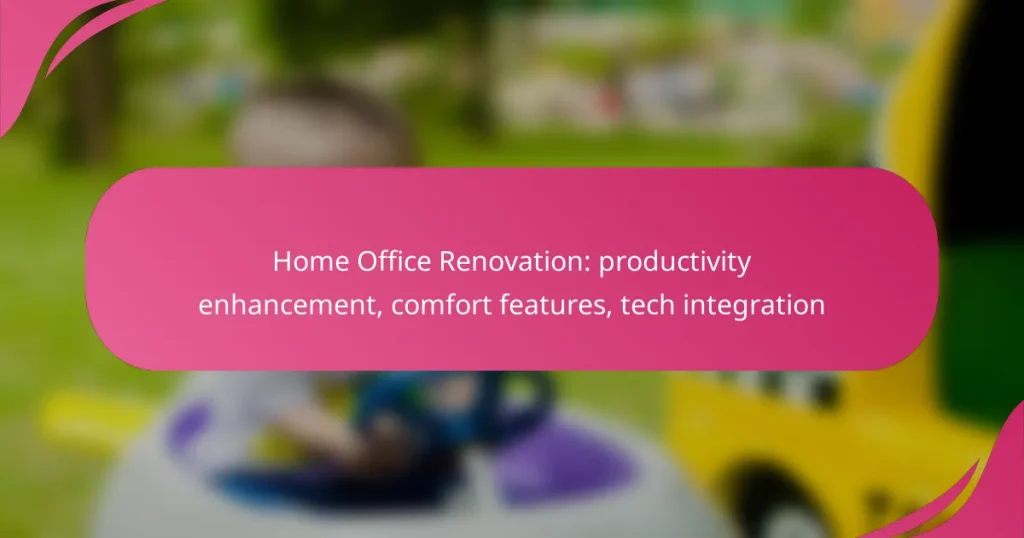Renovating your home office can transform it into a productivity powerhouse by creating a space tailored to your needs. By incorporating ergonomic furniture, optimal lighting, and advanced technology, you can enhance both comfort and efficiency, making work more enjoyable and effective.

How can home office renovation enhance productivity in Canadian homes?
Home office renovation can significantly boost productivity in Canadian homes by creating a tailored workspace that promotes focus and comfort. By integrating ergonomic features, optimal lighting, and effective organization, homeowners can enhance their work efficiency and overall well-being.
Ergonomic furniture benefits
Investing in ergonomic furniture is crucial for maintaining comfort during long work hours. Chairs with lumbar support and adjustable desks can reduce strain on the back and neck, allowing for better posture and less fatigue. Consider options like standing desks or chairs that encourage movement to keep energy levels high.
When selecting ergonomic furniture, look for products that meet recognized standards, such as those set by the Canadian Standards Association (CSA). This ensures that the furniture not only supports comfort but also adheres to safety guidelines.
Optimal lighting solutions
Proper lighting is essential for reducing eye strain and enhancing focus in a home office. Natural light is ideal, so position your desk near windows whenever possible. If natural light is limited, opt for adjustable LED lamps that mimic daylight to create a bright and inviting workspace.
Consider using task lighting for specific areas, such as desk lamps for reading or writing. Dimmers can also help adjust the brightness according to the time of day or task, fostering a more adaptable work environment.
Soundproofing techniques
Soundproofing your home office can minimize distractions and improve concentration. Adding acoustic panels or soundproof curtains can significantly reduce noise from outside or other areas of the home. Thick rugs and upholstered furniture can also absorb sound, creating a quieter atmosphere.
For a more permanent solution, consider installing soundproof drywall or insulation in the walls. This investment can enhance your work environment and increase the overall value of your home.
Organizational tools
Effective organization is key to maintaining productivity in a home office. Utilize shelving, filing cabinets, and desk organizers to keep essential documents and supplies within easy reach. Digital tools like project management software can also help streamline tasks and keep your workflow efficient.
Implementing a color-coded system for files and documents can make retrieval faster and reduce clutter. Regularly decluttering your workspace will help maintain an organized environment conducive to focus.
Space layout strategies
The layout of your home office can greatly impact productivity. Arrange your workspace to minimize distractions, placing your desk facing a wall or away from high-traffic areas. Ensure that your setup allows for easy movement and access to necessary tools and resources.
Consider the flow of the room; a well-planned layout can enhance comfort and efficiency. Use zoning techniques to separate work areas from relaxation spaces, helping to maintain a clear boundary between work and personal life.

What comfort features should be included in a home office renovation?
In a home office renovation, incorporating comfort features is essential for enhancing productivity and overall well-being. Key elements include adjustable desks, comfortable seating, and effective climate control systems, all designed to create a conducive work environment.
Adjustable desks
Adjustable desks allow users to switch between sitting and standing positions, promoting better posture and reducing fatigue. When selecting an adjustable desk, consider models that offer smooth height adjustments, ideally ranging from about 24 to 50 inches to accommodate various user heights.
Look for desks with programmable settings, which can save preferred height configurations for multiple users. This feature is particularly beneficial in shared home office spaces, ensuring comfort for everyone who uses the desk.
Comfortable seating options
Comfortable seating is crucial for long hours of work. Ergonomic chairs with adjustable features, such as lumbar support, armrests, and seat height, can significantly enhance comfort and reduce strain on the body. Aim for chairs that allow for a range of adjustments to fit individual needs.
Consider materials that promote breathability and durability, such as mesh or high-quality fabric. Investing in a good chair can prevent discomfort and potential health issues, making it a worthwhile expense in your renovation budget.
Climate control systems
Effective climate control systems are vital for maintaining a comfortable working environment. Options include air conditioning units, heaters, and smart thermostats that can be programmed to adjust temperatures based on your schedule. Aim for systems that allow for precise temperature control, ideally within a range of 20-22°C for optimal comfort during work hours.
Additionally, consider incorporating air purifiers to improve air quality, especially in enclosed spaces. A comfortable climate can enhance focus and productivity, making it an essential aspect of your home office renovation.

How to integrate technology into a home office renovation?
Integrating technology into a home office renovation enhances productivity and comfort. Focus on smart devices, reliable internet, and effective collaboration tools to create a functional workspace.
Smart lighting systems
Smart lighting systems adjust brightness and color temperature based on the time of day or your specific tasks. Consider options that allow you to control lights via smartphone apps or voice commands for added convenience.
Look for systems compatible with popular smart home platforms like Google Home or Amazon Alexa. This integration can help create a more comfortable and productive environment, reducing eye strain and improving focus.
High-speed internet solutions
Reliable high-speed internet is crucial for remote work, especially for video conferencing and large file transfers. Evaluate options such as fiber-optic connections, which typically offer the fastest speeds, or cable internet as a solid alternative.
When choosing a provider, consider plans that offer download speeds of at least 100 Mbps for seamless performance. Additionally, investing in a quality router can enhance coverage and minimize dead zones in your home office.
Collaboration tools and software
Collaboration tools and software streamline communication and project management for remote teams. Popular options include platforms like Slack for messaging and Trello for task management, which can help keep projects organized and on track.
Ensure that the tools you select integrate well with your existing workflows and are user-friendly. Regularly assess the effectiveness of these tools to adapt to changing team needs and improve overall productivity.

What are the costs associated with home office renovations in Canada?
The costs of home office renovations in Canada can vary significantly based on factors such as size, materials, and desired features. Homeowners typically spend anywhere from CAD 5,000 to CAD 30,000, depending on the extent of the renovation and the technology integrated.
Average renovation costs
On average, a basic home office renovation in Canada may cost around CAD 10,000 to CAD 15,000. This budget often covers essential upgrades like new furniture, paint, and lighting. For more extensive renovations that include tech integration and custom cabinetry, costs can rise to CAD 20,000 or more.
Labor costs can also impact the overall budget, with professional services typically ranging from CAD 50 to CAD 150 per hour, depending on the contractor’s experience and location.
Budgeting tips
To effectively budget for a home office renovation, start by determining your priorities and setting a clear budget range. Allocate funds for essential items first, such as ergonomic furniture and adequate lighting, before considering luxury features.
It’s wise to include a contingency of about 10-15% of your total budget for unexpected expenses. This can help cover any surprises that arise during the renovation process.
Cost-saving materials
Choosing cost-effective materials can significantly reduce renovation expenses. For instance, laminate flooring can be a budget-friendly alternative to hardwood, while still providing a professional look. Additionally, opting for ready-to-assemble furniture can save both money and time.
Consider using paint instead of wallpaper for a fresh look, as paint is generally less expensive and easier to apply. Look for sales or discounts at local home improvement stores to find quality materials at lower prices.

What are the essential steps for planning a home office renovation?
Planning a home office renovation involves assessing your needs, setting a timeline, and integrating technology effectively. These steps ensure that your workspace enhances productivity and comfort while meeting your specific requirements.
Assessing space requirements
Begin by evaluating the available space for your home office. Consider factors such as the size of your desk, storage solutions, and any additional equipment you may need. Aim for a layout that allows for easy movement and minimizes distractions.
Measure your room dimensions and create a floor plan to visualize your setup. A common recommendation is to allocate at least 100 square feet for a functional office, but this can vary based on personal needs and the type of work you do.
Setting a renovation timeline
Establishing a clear timeline for your home office renovation is crucial for staying on track. Start by outlining key milestones, such as design approval, purchasing materials, and completing the installation. A typical renovation might take anywhere from a few weeks to several months, depending on the scope of work.
Consider potential delays, such as shipping times for furniture or permits for electrical work. To avoid pitfalls, create a buffer in your schedule and prioritize tasks that may take longer than expected. Regularly review your progress to ensure you remain aligned with your timeline.


